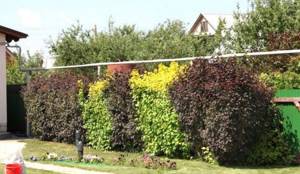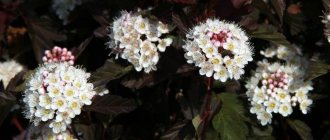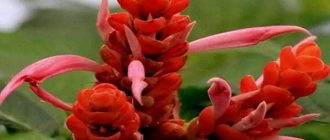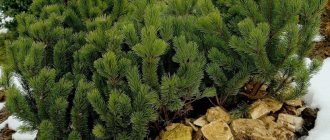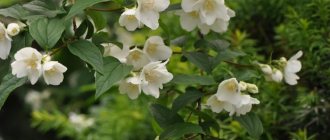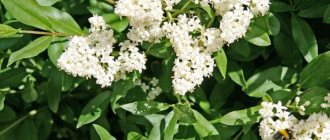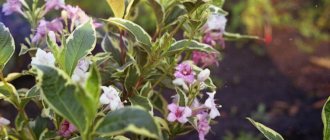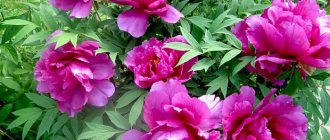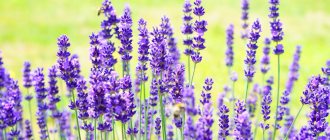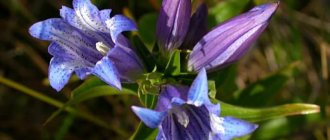Viburnum foliage came to us from the countries of East Asia and North America. It first appeared on the pages of botanical reference books in 1793. The first attempt at cultivation was made in 1836. Since then, bushes have been a decoration of gardens and galleries not only for lovers of exotic plants; over time, it has taken its rightful place among bushes. The main habitat is river banks and dense forests; it is often found on the slopes of rocks.
Currently, it is used for hedges, as well as for group or single plantings, as a garden decoration. This is one of the plants that should be protected in protected areas, despite its widespread occurrence in urban plantings. One of its names is spirea caulnofolia. Now it has ceased to be exotic and is found in almost all countries of the world.
Description of the plant
This is mainly a shrubby species. Rarely reaching a height of more than 3 meters. But it can grow up to 4 meters or more in width. The leaves of the bladderwort look like the blades of a motorboat propeller. The texture is very similar to coltsfoot greens. The front side is dark green in color with a hard skin; the back side has padding resembling gray felt.
Like all shrubs, the viburnum-leaved bladdercarp bears fruit; its fruits have the appearance of swollen leaflets, which, when ripe, become reddish in color, which gives the plant a picturesque appearance.
Bladderwort viburnum flowers and fruits
The flowers also do not disappoint: they reach 15 millimeters in diameter, gathering together in single inflorescences of 10 - 15 pieces of umbrellas per branch. Most varieties have white flowers that bloom for about 20 – 25 days.
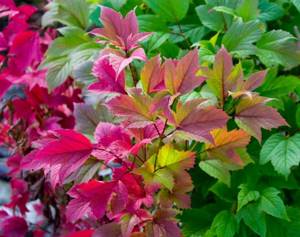
In addition to flowers, the shrub has leafy leaves, which in autumn can acquire a reddish tint or turn yellow. Plants in which the edges of the leaves acquire a golden color deserve special consideration.
Young shoots look like chestnut-colored shoots with smooth skin. As the bark matures, it acquires a rough structure that peels off in the form of longitudinal stripes.
The plant tolerates frost quite stably in winter. One of their characteristic features is resistance to all types of weather. Bladderwort easily tolerates dry soil and is absolutely not demanding of sunlight. It can be considered an ideal plant that requires virtually no care. Moreover, the average lifespan of a vesicular carp is about a quarter of a century, and it grows literally before our eyes, adding up to half a meter per year, reaching an “adult” height in three to four years.
Planting and caring for yellow-leaved bladderwort
This crop is undemanding to soil composition and can grow in one place for up to 40 years. The annual growth is about 40 cm in height.
It is necessary to place the vesicle in open sunny places, protected from drafts. With a lack of light, the color of the leaves will not be as bright as possible. The plant prefers loams with low or neutral acidity levels. When planting in a hole, you need to add a mixture of turf, humus and sand in a ratio of 2:1:1. Also, a layer of drainage 5-7 cm thick should be laid at the bottom, which will prevent moisture stagnation at the roots.
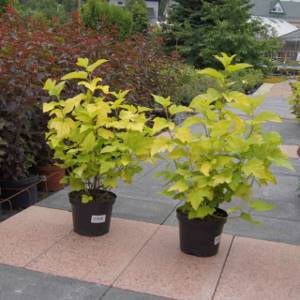
In the Angel Gold variety, by autumn a bright orange border or strokes in the center may appear along the edge of the leaf blade.
After this, sprinkle the roots with soil, compact the surface of the soil at the base and water generously. The next day, mulch the root circle with peat so that air can easily penetrate to the roots.
Important! Almost all types of yellow bladderwort do not tolerate stagnant moisture, so they need to be planted in well-drained soil.
When using the crop for hedges, seedlings should be planted in a checkerboard pattern, maintaining a distance of 45 cm, and row spacing should be left 35 cm wide.
In the future, it is necessary to monitor the soil moisture, avoiding drying out and waterlogging of the roots. In the absence of precipitation, watering should be done 1-2 times a week, depending on the air temperature and the rate of evaporation.
It is recommended to feed seedlings from 3 years of age. To do this, in the spring during the growing season, you should fertilize the plants with mullein 1:10 or chicken manure 1:20. And before winter, water with 40 g of superphosphate and 30 g of potassium sulfide per bucket of water.
To form a beautiful bush, yellow bladderwort needs to be pruned regularly, removing broken and damaged branches. In addition, if desired, the crown can be formed in the form of a ball, a cylinder, and also for a hedge in a straight line.
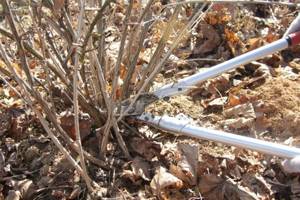
Once every five years it is recommended to carry out anti-aging pruning, removing all old shoots at the base
Advice! Adult bladderwrack bushes do not need shelter for the winter, and young seedlings up to three years old should be insulated with spruce branches or a cap made of roofing material should be made for them.
Bladderwort varieties
The bladderwort got its name because of the specific type of fruit; they resemble a bubble, expanded in the middle, and in the upper part they look like a brush. In its genus it has fourteen species. There are several hundred varieties in total. They are obtained naturally and through hybrid propagation. The main differences are the height of the shrub and the color of its leaves. Thirteen varieties are native to North America. And its unpretentiousness allowed it to spread throughout the world.
Variety Diablo
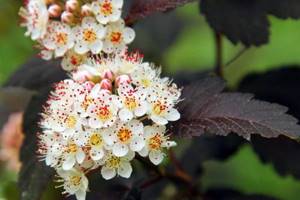
Bladderwort viburnum variety "Diablo"
The most widespread plant is called Diabolo; its trunks rarely reach a thickness of more than one centimeter. The leaves have sharp, burgundy tips that turn yellow in the fall. It resembles Russian mountain ash in flowers, but blooms in June and July.
The shrub variety Nanws is characterized by its short stature; it rarely grows to a height of more than one and a half meters. Its leaves are small and do not have any shades.
From crossing Nanus and Diabolo, a species called Summer wine was obtained. In the size chart, the plant is located in the middle between Nanus and Diabolo, but has thicker trunks and in appearance resembles fireworks, soaring and simultaneously breaking up into many small splashes. Its flowers are white with a pinkish tint, they are located along the length of each of the branches. The bark, like the leaves, tends to dark burgundy in color. Nevertheless, the plant, despite its summer appearance, tolerates frost well.
Variety Luteus
Of all the varieties, Luteus stands out with its fashionable coloring.
The beginning of flowering is marked by the yellow color of the leaves, which by the end of the summer period becomes saturated green. Luteus, with its spherical shape, will serve as an excellent decoration for any estate.
The plant will tolerate city conditions well and is not afraid of light or shadow.
Variety Golden Arrows
Another variety is Dart's Gold; the plant deservedly received its name because of its leaves, which change color from bright yellow to rich orange. The same cannot be said about flowers that are white or cream and do not stand out in any way.
Diable D'or was obtained from Devil and Golden Arrows. From the first it acquired quite a tall growth, from the last the color of the leaves, only not yellow, but with a hint of copper, which turns into red. It is also called purple, which is confirmed by the fruits turning from light green to burgundy.
Variety Red Baron
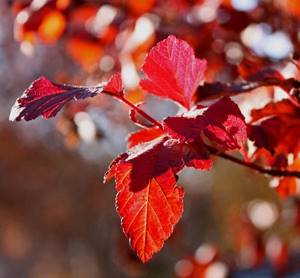
Red Baron bladderwort
Red Baron is perhaps the most common variety of bladderwort. It easily takes root in any climate and on almost any soil. What earned him the veneration of fans of hedges. Its growth is consistently one meter, but wide leaves about eight centimeters long will hide any territory from prying eyes. One of the most compact types of shrubs. Diablo bladderwort tolerates propagation best by cuttings.
Nugget is a hybrid species with an upward-sloping figure, shaped like a bottle. Also changing leaf color depending on the season.
The Coppertina variety is distinguished by pink buds, which is not found in other varieties.
Aurea, Aurea's bladderwort , starts out right away with yellow, lemon-tinged flowers. The bush will allow you to create an original landscape design.
Having begun its world tour, the bladderwort began to number more than 300 varieties.
The best varieties of yellow-leaved bladderwort
There are several yellow species of this shrub. When breeding them, breeders pursued the goal of obtaining plants of compact size with contrasting leaf colors. But, despite the general qualities, each variety of golden vesicle has certain differences that you need to pay attention to when choosing to decorate a site.
Luteus
This variety is characterized by a lush, spreading bush that reaches a height of 2.5-3 m and a width of 4 m. But with regular pruning, you can get a dense crown, which will only improve the decorative qualities of the vesicle. The branches grow upward, but the ends droop slightly. The flowers are creamy white.
At the beginning of the growing season, the leaves of Luteus are rich yellow, with the onset of summer they acquire a light green tint, and in the fall they become crimson. The plates are decorated with a carved edging along the edge.
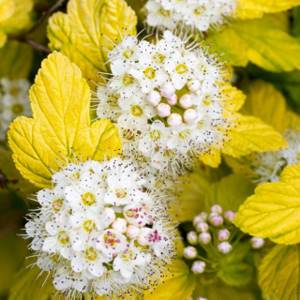
The shape of the leaves of the Luteus variety is very similar to grape leaves.
Gold Spirit
This variety of bladderwort is characterized by a yellow tint to the leaves. An adult plant is compact in size and reaches a height of no more than 2 m. It easily tolerates pruning and quickly grows a lush crown.
Important! The Gold Spirit variety retains a yellow tint of foliage from the beginning to the end of the growing season.
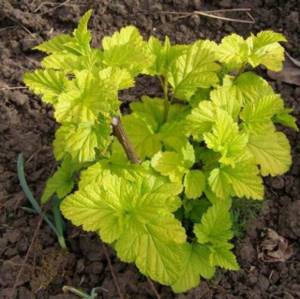
This variety of bladderwort looks impressive against the background of a green lawn
Nugget
This species was created thanks to the efforts of American breeders. The height of an adult vesicular carp reaches 2.5 m.
The leaves have a bright yellow color when they bloom, acquire a green tint closer to summer, and become golden again by autumn. The size of the plates is significantly smaller than that of other viburnum-leaved yellow vesicles. Nugget's flowers are white and cream.
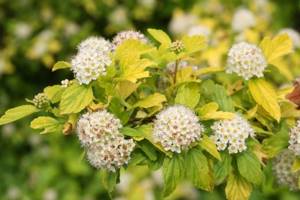
Nugget differs from other species in its thick stems that grow exclusively upward
Aurea
This type of bladderwort is characterized by a hemispherical crown with spreading branches. The height of an adult plant reaches 3 m. The color of the leaves varies depending on the period of the year. In spring the shade is yellow, in summer it is greenish, and in autumn it is golden.
Aurea flowers are white, 1.2 cm in diameter, with numerous bright stamens. The fruits turn red when ripe.
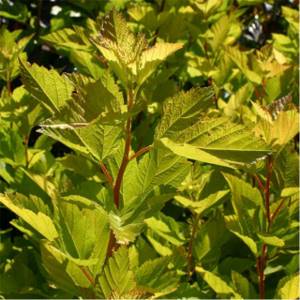
Aurea shows the greatest decorative qualities when grown in an open sunny area.
Golden Nugget
The variety is characterized by enhanced shoot growth. An adult bush grows up to 2 m, while the diameter of the bush is also 2 m. The color of the leaves of the Golden Nugget, like many other types of bladderwort, changes throughout the season. Initially it is rich yellow, then becomes light green, and closer to autumn it acquires its original shade. The flowers of the Golden Nugget variety are white and pink with a pleasant, unobtrusive aroma.

The culture develops well in partial shade, but the leaves do not turn bright yellow.
Enis Gold
This variegated variety of bladderwort is distinguished by its compact bush size up to 2 m high and dense leafy crown. The color of the plates lasts throughout the season. The leaves are painted with yellow-green strokes, forming a peculiar pattern.
Despite the fact that Enis Gold is not characterized by a golden hue, this does not reduce its decorative qualities.
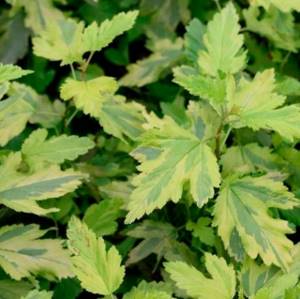
Enise Gold leaves are shaped like currants
Amber Jubilee
The variety was obtained by British breeders. An adult shrub of this variety does not exceed 1.5 m in height. The edge of the leaf blades is serrated. Their color is initially purple-yellow, then changes to green and turns orange at the end of the season.
The flowers are white, collected in hemispherical inflorescences, which look fluffy due to the numerous stamens.
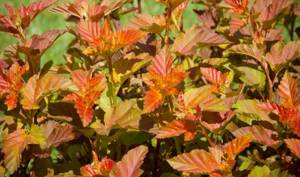
Amber Jubilee was obtained by crossing Darts Gold and Diablo varieties
Darts Gold
A Dutch variety of bladderwort, characterized by a compact bush shape, the height of which reaches 1.5 m. The leaves of this species, when blooming, have a bright yellow color with an orange tint; with the arrival of the summer heat they become green, and in the fall they once again change their shade to crimson.
In June, white-cream corymbose inflorescences appear on the bush. Darts Gold is considered one of the most popular viburnum-leaved bladderworts with golden-hued foliage.
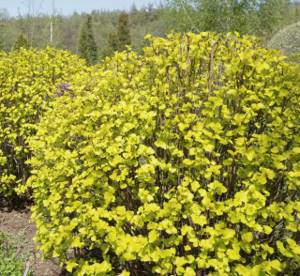
This hybrid was obtained by crossing varieties such as Luteus and Nanus
Angel Gold
This variety forms a bush 2-2.5 m high. Its branches grow vertically, slightly spreading. The leaves at the beginning of the growing season have a lemon-yellow tint, then become green in the summer, and in the fall they acquire their original shade. The plant is characterized by rapid growth.
The flowers of this species are white with a pink tint. The fruits ripen at the end of August and stay on the shoots for a long time, increasing the decorative qualities of the plant.
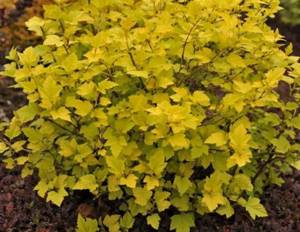
In the Angel Gold variety, by autumn a bright orange border or strokes in the center may appear along the edge of the leaf blade.
Planting a bush

Planting a bladderwort
The plant is completely unpretentious and tolerates both light and shadow. But in the latter case, the color of the leaves will be paler, so it is better to choose a place for planting that will be more exposed to sunlight.
The type of soil practically does not matter, but the most acceptable is the one that contains less lime and alkalis, in other words, the least oxidized soil. The plant tolerates air saturation with harmful gases well; creating a hedge along the road will be an excellent solution.
IMPORTANT
In order for the bladderwort to retain all its properties, it is not advisable to plant it from seeds. Only half of the offspring get the original color. Therefore, the best option would be to purchase seedlings in specialized shopping centers.
The instructions for planting viburnum vesicle are quite simple:
- A hole is dug, the depth of which does not exceed fifty centimeters.
- A peat cushion is used as drainage. You can add humus to it.
- It is advisable not to destroy the lump of earth with roots.
- After the plant is placed in the hole, it is covered with earth, but not compacted.
- The last step will be abundant watering. It is best to add trace elements containing potassium, manganese, phosphorus and molybdenum. One of the latest developments is the drug “Kornevin”. It improves the survival rate of almost any plant and is quite easy to use.
It is advisable to sprinkle the surface with sawdust after planting. They will prevent excessive moisture removal and prevent weeds from destroying the young plant. They will not allow beneficial substances to “bleed away” from the soil.
Video - instructions “How to plant viburnum leaf carp”
Reproduction of bladderwort
One of the most important issues in gardening is plant propagation. The viburnum leaf plant allows itself to be planted in several ways.
- Propagation by seeds
The first method is propagation using seeds. The bladderwort produces them in large quantities. The seeds are brown in color and crackle when squeezed in your hands.
Bladderwort seeds are collected in November. Almost immediately planting. For them to germinate, a certain period of rest at zero temperature is required, the so-called stratification. It allows the seed to prepare for spring shoots and safely pass through autumn and winter. For vesicular carp, this period is two months; the temperature should be between zero and five degrees.
- Propagation by cuttings
The second method is propagation by cuttings. The important thing is that only an adult plant can be propagated using this method. Bladderwort cuttings are cut at the end of July. Trying to have at least two or three branches of leaves attached to each one. The lowest ones are removed, all the rest are shortened by half.
The cuttings must be dipped in the Kornevin solution to stimulate the formation of the root system.
It is best to plant in a mixture of sand and peat. When planting in open ground, there is no need to plant more than 10 plants per square meter, keeping a distance between seedlings of about 80 centimeters.
In winter, it is necessary to wrap the cuttings in polyethylene, and in the spring months, plant them in a permanent place. Moreover, it is advisable to trim it after planting so as not to waste extra effort on maintaining healthy foliage. The cut areas are treated with a solution of potassium permanganate.
When propagating a plant, it should be remembered that the heirs do not always receive the characteristics of the parent tree. This is especially pronounced with the seed method. In general, the technology is standard and similar to the methods of propagation of any shrubs.
Video “Cuttings of bladderwort”
Plant care
For all its unpretentiousness, the viburnum leaf carp requires little care. Which basically comes down to watering, pruning and feeding the bushes. Which in general will not pose any problems even for a novice amateur gardener.
- Watering
One plant bush will require at least 40 liters of water. You should not water the bush often; once a week is enough. The best time is just after dawn or before sunset. But compliance with the measure is important, since the plant is critical of transfusion and stagnation of water.
- Top dressing
At the beginning of autumn, viburnum-leaved bladdercarp is fed with ammonium nitrate, urea or fertilizers with a mullein base.
Before winter, it is necessary to apply nitroammophoska to the plants. Two tablespoons of fertilizer are diluted per ten liters of water.
- Preparing for winter
To prevent the bushes from freezing, the soil under them is sprinkled with sawdust, and the plants themselves are wrapped.
For plants that have been planted recently, the best shelter will be spruce branches.
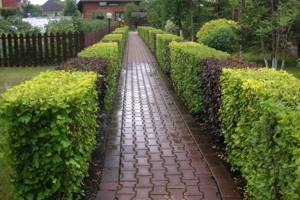
Bladderwort hedge
Secrets of planting and care
Planting and caring for yellow-leaved varieties of bladderwort is not much different from purple and emerald varieties. The rules are quite simple:
- It is best to buy planting material that is grown in containers. Plants with a closed root system can be planted throughout the warm season.
- Planting holes should be slightly larger than the size of the root system. Usually they are made with a depth and diameter of at least 50 centimeters. A layer of nutrient soil is poured into the bottom of each pit, which must contain peat.
- Young bladderwort seedlings, together with a ball of earth, are placed in planting holes and covered with a layer of fertile soil. The shoots can be buried 3–5 centimeters to give impetus to the development of dormant buds, from which new shoots will grow.
- Abundant watering of young seedlings is a prerequisite for planting. In order for the plants to take root painlessly, they can be watered with the Kornevin solution.
- Tree trunk circles can be mulched with ordinary soil. This procedure will help retain moisture and also prevent the formation of an earthen crust. At the same time, the roots will receive a sufficient amount of oxygen.
- The frequency of watering depends on the growing conditions of the shrubs. During the hot period, they can be watered a couple of times a week, pouring up to 30 liters of water under each bush. This procedure should be approached with caution in areas where loamy soils predominate and where there is a danger of moisture stagnation.
- Pruning the bladderwort can be done immediately after planting. It will promote better branching of shrubs. Sanitary haircuts are carried out as needed. But formative pruning - in early spring, even before the buds open, or in late autumn, when the growing season ends.
Pruning viburnum leaf carp
To emphasize the beauty of the viburnum leaf carp, its crown must be trimmed.
Trimming includes:
- the formation of the crown of a bush consists of cutting young shoots to half their length;
- removing all damaged leaves during the wintering period of the plant;
- it is also necessary in March and November to remove all old shoots that will no longer bear a blooming appearance;
- decorative pruning, expressed in the formation of the design of a garden or hedge; if it is done correctly, then many additional shoots will grow from the bush.
The result of all activities will be a dense and beautiful crown, which will be free of harmful insects. The only disease to which the viburnum leaf carp is susceptible is rotting of the root system if the soil where it is planted is too heavy or there is excess moisture. In such cases, it is necessary to wash off the earthen lump from the root system under running water, cut off the damage, rinse everything with potassium permanganate and transplant the shrub to a new place.
Video “Pruning viburnum vesicle”
Diseases and pests
Yellow bladderwort is resistant to diseases and pests. Since the shrub does not like waterlogging, if water is added in excess, powdery mildew may develop, which leads to the death of the seedling.
Due to a lack of nutrients (iron, magnesium), chlorosis can develop, which is characterized by yellowing and drying of young shoots that is unusual for the variety. To get rid of the problem, it is enough to spray the plant with iron and manganese preparations (Antichlorosis, Chelate, Ferrilene, Ferovit) at the root.
Designer delights
Viburnum foliage will decorate any area, becoming a real highlight for it. The shrub looks exceptionally well both when planted alone and in a group of other plants.
If you plant it more densely, you will get a beautiful hedge that will not only decorate the landscape, but also serve as a magnificent fence.
Video “Hedge made from bladderwort”
Thanks to their color scheme, the leaves of the vesicular carp will give the garden an elegant look. And the seeds, with their characteristic crunch, will become a wonderful toy for small children.
Golden bladderwort in landscape design
In Russia, yellow vesicular carp has been used as an ornamental plant since the mid-19th century and is widely used for landscape design: hedges, for dividing an area into zones, and also for decorating borders. Looks great both in single and group plantings.
Due to the fact that yellow bladderwort tolerates gas pollution well, it can often be found in city squares and parks. Even close to the road, the bush will grow well and create protection from exhaust gases and dust.
Due to the fact that the shrub tolerates pruning well, it is possible to give it any shape (cylinder, ball, line).
Yellow bladderwort can be grown in the sun or in partial shade or shade. To make varieties of shrubs with golden, yellow and purple leaves look bright and beautiful, they are recommended to be planted in sunny places.
When forming hedges, varieties with red (purple) and golden (yellow) leaves go well together. And purple varieties will be an excellent background for light-colored perennial shrubs.
The yellow bladderwort looks original next to coniferous shrubs such as thuja and juniper.
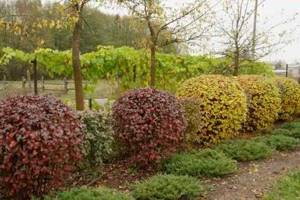
For example, the greenish-yellow Darts Gold will look great in combination with the burgundy-bronze Red Baron or the golden Nugget with the purple Diable Door variety. These compositions can be planted alternating colors or parallel to each other.
For fencing a playground or separating a vegetable garden from a local area, varieties of low yellow bladderwort such as Amber Jubilee or Darts Gold are perfect.
